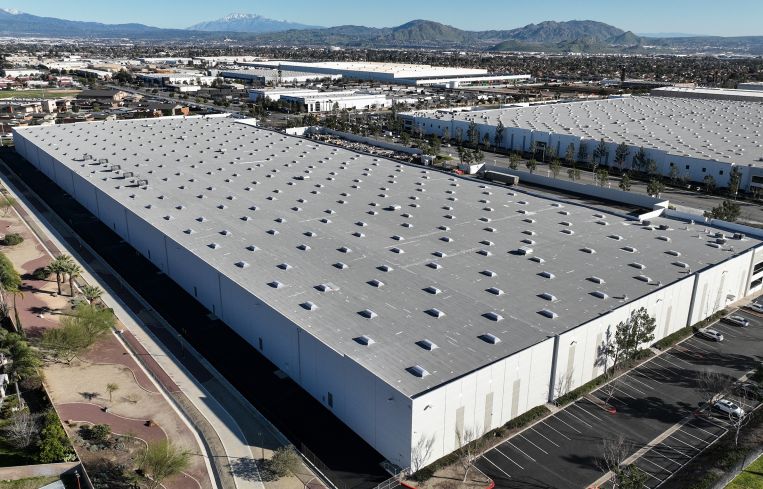WiredScore Expands Into Industrial Real Estate
The sector’s tech connectivity race is on, and the global digital certification giant is here for it
By Philip Russo November 11, 2025 9:00 am
reprints
WiredScore, a global firm that specializes in digital certifications for property, announced Tuesday that it has expanded its services into the U.S. industrial and logistics real estate sectors.
The move comes as a response to industrial tenant demand for better tech-enabled spaces, said John Meko, vice president of North America and global operations at Manhattan-based WiredScore.
“We’ve been asked to come to the industrial sector for some time,” said Meko. “Before we go into any new asset class, we do as much research as possible to make sure that we’re actually solving a pain point for the users of that asset class through our certification. We did about two years of research into industrial before making a foray into the market, basically talking to all the leading owners, landlords and developers across the ecosystem under the guidance of the major occupiers globally, to get some signal through the noise as it relates to what’s most important for industrial tenants moving into into a new space.”
WiredScore found that the common theme among industrial occupiers was that foundational and reliable connectivity in their industrial logistics facilities has been a growing challenge as the amount of technology their businesses were adopting to be competitive and operationally efficient grew.
The pattern followed what WiredScore had seen when it was founded in 2013 to rate digital connectivity in New York City’s office market as it was competing with Silicon Valley to attract technology companies. Similarly, WiredScore entered the multifamily sector in 2019, and quickly saw demand accelerate during the COVID crisis, as many people began working from home.
“We launched in the U.K. and Europe back in March as a proof of concept in industrial and logistics, and we’re now looking into North America for the pain points that we’ve heard across the ecosystem,” said Meko. “The industrial sector has real needs to be met, and we’re well positioned through our scorecard and our certifications to help users ultimately find buildings that can meet their needs from a digital infrastructure perspective.”
In Europe, 28 major real estate developers and landlords, including Hines (as development managers), LaSalle Investment Management, Panattoni, Prologis and Segro, are among WiredScore’s launch partners, the company announced in July 2025. The companies are using WiredScore’s international digital connectivity rating certification system to analyze, improve and promote their buildings’ digital connectivity and other smart infrastructure. That includes internet service, mobile phone performance, sustainability technology, infrastructure setup, technology resiliency, and future readiness, according to WiredScore.

Globally, WiredScore is working with 35 clients in the industrial sector, including U.S. companies such as Trammell Crow. The company’s clients have portfolios that include new construction and existing spaces, each of which has various digitalization needs, he said.
“If you’re building ground-up, you want to get the foundational elements right,” Meko said. “That’s the best point in time to future-ready your asset. We’re also working on a lot of repositioning assets, which seems to be a common theme in the U.S., specifically. You have a lot of owners that have tenants in their industrial facilities that are lower-tech users, and they are rolling out of those spaces and potentially moving to other offices.”
The nature of the U.S. industrial ecosystem is somewhat unique, he added.
“The leasing ecosystem in the U.S. is heavily driven by more technology-centric users,” said Meko. “So advanced manufacturing, robotics, third-party logistics companies that have really hyper-digital workflows for operations. The owners that we’re working with are looking to reposition those assets to ensure they can meet those customer demands. From a technology standpoint, some of our owners also just have existing portfolios that they don’t really understand as it relates to technology. So our certification is essentially a mechanism for getting their arms around what they have in those buildings so they can better understand what they need to do to meet the needs of today and tomorrow’s tenants.”
WiredScore aims to help owners attract tech-savvy tenants who want those high-tech facilities.
“That’s always kind of the theme,” said Meko. “An owner-operator doesn’t really react or change anything until it starts becoming a tenant norm and expectation. Over the last 10 years, we have moved to where sustainability became front and center for industrial tenants and you started to see electrification of their fleets. Owners want to incorporate EV charging into warehouse facilities to be able to meet that demand for tenants. Over the last five years, you’ve seen more advanced [Internet of Things] being integrated into that hardware and those machines. So you’re looking at predictive maintenance, understanding runtime on those devices, integrating it into warehouse management systems to better understand how the facility as a whole is operating.”
Perhaps more than other real estate sectors, that theme extends across the industrial market, Meko continued, noting that the pace of technology adoption is a lot faster because there’s tangible return on investment for tenants when investing in technology for greater efficiency (think AI in distribution warehouses).
Another factor in the digitalization of the industrial sector is that technology plays a large part in creating more comfortable user-ready offices for people working in warehouses.
“Amazon had a huge push for this over the last few years as it became a lot more public about how poor some of the conditions were in those facilities,” said Meko. “So the landlord side of the ecosystem is putting in a lot more prebuilt offices into warehouse facilities. Like most new construction, you’re basically always going to have a spec suite that’s built out for the office users within the warehouse. Digital connectivity is a big part of that hook for developers and an opportunity to differentiate. So ensuring that you actually get turnkey connectivity on day one when you’re moving into the space is a point of differentiation for owners, because it’s a super competitive market.”
Despite data centers currently driving the industrial market, Meko said that slice of the sector is not a focus for WiredScore.
“Given the dynamics of that use case, which is being driven basically by hyperscalers that have their own staff that they bring in anytime they’re building or operating a facility, all our focus has been on industrial and logistics in terms of core asset classes,” he said. “That’s warehousing, manufacturing, as well as third-party and last-mile logistics facilities, which are also seeing the same push in terms of technology.”
Philip Russo can be reached at prusso@commercialobserver.com.



